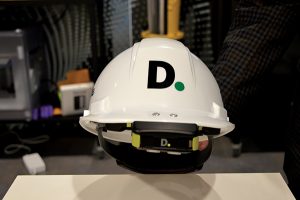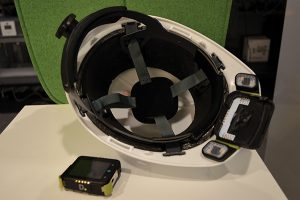What the wearables era will mean for mining
It started with the arrival of personal computers, which changed our lives significantly, both at home and at work. Then, along came the internet to connect us in ways we’d never before imagined.
In the last decade, the mobile revolution placed powerful, general-purpose computing in our hands, enabling users to take actions in the digital world while moving about in the physical one. What’s next?

Deloitte has partnered with software developer
Vandrico and hardware developer Cortex Design to produce a smart helmet. The wearable attachment has sensors to measure levels of methane, carbon monoxide, diesel fumes and radiation. CREDIT: DELOITTE
Devices continue to become smaller, faster, smarter and hyper-aware – welcome to the Wearables era.
The original definition of Wearables was: electronic devices capable of storing and processing data that can be worn as an accessory or as a part of material used in clothing.
Over time, the definition of wearables has evolved to: electronic devices worn by people to enhance their capabilities and extend how they interact with both the physical and digital worlds.
Like any emerging technology, obstacles can slow down the adoption of wearables. But usability, battery power, data accuracy, lack of standardization, privacy concerns, and stakeholder acceptance continue to be addressed. Early experiments are showing clear use cases where wearables have overcome these barriers to help control costs, improve productivity, enhance efficiency and improve processes. These barriers will continue to be addressed and the benefits will continue to increase in visibility.
Wearables are now ready for enterprise use due to three important factors:
- Clear return on investment: A growing number of companies have woken up to the potential of wearables and are testing applications within their businesses.
- Breadth of wearable device capabilities: The expanded set of sensors in wearables today provides incredible potential for innovators to create rapid prototypes and solve real-world problems. These sensors offer a range of capabilities that enable users to connect seamlessly with the digital world. Over time, simple sensors integrated into wearable devices will make way for sophisticated devices with multiple sensors. It is believed that the average wearable device shipped in 2019 will incorporate 4.1 sensor elements, as compared to the 1.4 that were standard in 2013.
- Disappearing barriers: In recent years, device manufacturers have invested heavily in reducing sensor power consumption and size. Key technologies such as micromachining have enabled greater miniaturization of sensors, addressing some of the barriers that once stood in their way.
The confluence of a number of factors has created a significant wearables opportunity in mining. Apart from the above mentioned factors around miniaturization, processing power, battery life, etc., the advent of underground Wi-Fi in mining coupled with the desire to improve underground mine safety and the ability to process large amounts of data with advanced analytics tools to gain uncommon insights, has created the conditions for wearables to solve meaningful business problems.
When wearables are used in conjunction with underground digital mining platforms, they have the ability to communicate and address multiple issues such as air quality (diesel particulate, gas levels, dust levels, temperature), location tracking using RFID (radio-frequency identification) tags, worker down alerts through accelerometers and last known position tracking during seismic events. These functions are largely passive and can be delivered through clothing, body and or helmet mounted technologies. Body mounted technologies have the added advantage of being able to monitor heart rate, body temperature and other biometric indicators to help manage fatigue, although some privacy issues have not yet been totally overcome in the biometric sphere.
Many of these technologies have been tested and refined for underground application and the expectation is that the connected mine of the near future will use wearables and equipment-based sensor technologies (IoT) on common digital platforms to improve human safety and performance but also to optimize how humans and machines work together to improve the overall safety and efficiency of underground mining operations.
The author is a partner, National Consulting Energy & Resources leader at Deloitte and can be contacted at jbeier@deloitte.ca.
Comments